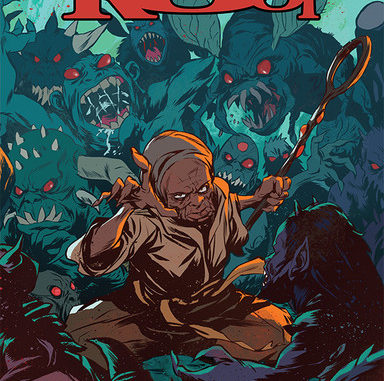
On the cover of issue three of ‘Bitter Root’ Ma Etta, the matriarch of the Sangerye family, reveals the tenacity of a black woman who has lost too much and is relying on all her root-working techniques to save the people she loves. The look on Ma Etta’s face tells the reader that she isn’t about to lose any more family members. But the problems being faced in Harlem where some of the Sangeryes reside aren’t only there. Its tentacles seem to extend to Mississippi where a member of the family gathers valuable information and heads towards Harlem. There’s a lot at stake considering the monsters or Jinoo as they’re called are starting to outnumber the regular people screaming around in terror.
These beings, well-drawn creatures, are not like the Jinoo that the Sangeryes have been hunting down for years. Instead, they’re something more insidious. In the comic the typical Jinoo is a human, so consumed by hate he or she is turned into this hideous figure. However, once they’ve been injected with a serum made by Ma Etta, they revert back to human beings. In the second issue when Berg, the rather large black man who drinks from a civilized teacup is infected, it turns him into a thing that turns on his family. Berg becomes formidable and there isn’t enough serum to calm him down. Let loose he could destroy them all. That’s where the reader sees how Ma Etta has earned her reputation. Similarly, the comic from the first page simultaneously tells three aspects of the story, showing how complex the situation has become. Though it may appear nontraditional, the panels are clearly understood. Your eye instinctively goes to the correct scene. It shows that the actions happening in one area affects what’s occurring in other parts of the country. Berg’s struggle is connected to what’s happening in Mississippi. It’s another layer of inventive storytelling that forces you to pay attention.
What also makes this comic-book a pleasure to read is that it assumes you’re an intelligent, quick individual who doesn’t need everything to be explained to you. The struggle the family is going through, battling monsters can be understood as a metaphor for all types of monstrous things in our lives. The thing is that in order to defeat evil sometimes you have to get over yourself and get help. It’s what Blink must do when the man she blames for the death of those closest to her maybe the only one to help Berg. Then there’s Doctor Sylvester and Miss Knightsdale. They seem to be embracing a monstrosity they’re afflicted with. But is it an affliction? You’re not sure how they play a part in this narrative. Still, their mystery adds to the ongoing story. Did they contract this new form of Jinoo? Another thing to consider is that you have no clue as to how this is going to be resolved. Just when you believe you know where the story is going, it takes a jagged turn.
And after the comic is over there’s some knowledge dropped on you about how root-working functions in the Black community. It is one of the few things passed down and engrained in not only the lexicon of black culture, but in the blood. Regina N. Bradley describes the intricacies of root or what she refers to as ‘rut.’ It happens to be the best way to contextualize the relationship between Ma Etta and Blink. An older, wiser woman who is desperately trying to teach this young woman about the importance of ‘rut.’ Not everyone fights battles with their fists and in order for tradition to live on, the next generation has to slow down long enough to learn. Lastly there’s a short bio and the importance of Zora Neale Hurston written by John Jennings. Hurston is integral to understanding the pulse of Harlem. Never one to do anything half-quarter, she was a writer, anthropologist and all around strong black woman. Hurston rarely held her opinions back. For the most part ‘Bitter Root’ from page one to the ‘Genius of the South: Thinking of Mother Zora,’ creators David F. Walker, Chuck Brown and Sanford Greene continue to tell an unapologetic story about the complexities of what it means to be black in America. Don’s sleep on this monthly series. Make it a staple in your pull list, download it as soon as it’s available. You can’t afford to miss what’s happening in this comic-book.

Leave a Reply